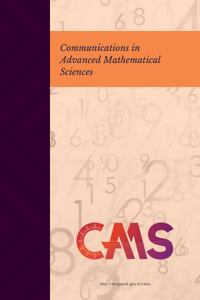Extended Newton-type Method for Generalized Equations with Hölderian Assumptions
Extended Newton-type Method for Generalized Equations with Hölderian Assumptions
In the present paper, we consider the generalized equation $0\in f(x)+g(x)+\mathcal F(x)$, where $f:\mathcal X\to \mathcal Y$ is Fr\'{e}chet differentiable on a neighborhood $\Omega$ of a point $\bar{x}$ in $\mathcal X$, $g:\mathcal X\to \mathcal Y$ is differentiable at point $\bar{x}$ and linear as well as $\mathcal F$ is a set-valued mapping with closed graph acting between two Banach spaces $\mathcal X$ and $\mathcal Y$. We study the above generalized equation with the help of extended Newton-type method, introduced in [ M. Z. Khaton, M. H. Rashid, M. I. Hossain, Convergence Properties of extended Newton-type Iteration Method for Generalized Equations, Journal of Mathematics Research, 10 (4) (2018), 1--18, DOI:10.5539/jmr.v10n4p1, under the weaker conditions than that are used in Khaton et al. (2018). Indeed, semilocal and local convergence analysis are provided for this method under the conditions that the Frechet derivative of $f$ and the first-order divided difference of $g$ are Hölder continuous on $\Omega$. In particular, we show this method converges superlinearly and these results extend and improve the corresponding results in Argyros (2008) and Khaton $et$ $al.$ (2018).
Keywords:
Divided difference, Extended Newton-type method, Generalized equations Lipschitz-like mappings, Semilocal convergence,
___
- [1] C. J. Alexis, A. Pietrus, On the convergence of some methods for variational inclusions, Rev. R. Acad. Cien. serie A. Mat., 102(2) (2008), 355–361.
- [2] I. K. Argyros, A unifying local-semilocal convergence analysis and applications for two-point Newton-like methods in Banach space, J. Math. Anal. Appl., 298 (2004), 374–397.
- [3] I. K. Argyros, Computational theory of iterative methods, Stud. Comp. Math. Elsevier, Amsterdam, 2007.
- [4] I. K. Argyros, S. Hilout, Local convergence of Newton-like methods for generalized equations, Appl. Math. and Comp., 197 (2008), 507–514.
- [5] J. P. Aubin, Lipschitz behavior of solutions to convex minimization problems, Math. Oper. Res., 9 (1984), 87–111.
- [6] J. P. Aubin, H. Frankowska, Set-valued analysis, Birkh¨auser, Boston, 1990.
- [7] M. C. Ferris, J.S. Pang, Engineering and economic applications of complimentarity problems, SIAM Rev., 39 (1997), 669–713.
- [8] J. P. Dedieu, M. H. Kim, Newton’s method for analytic systems of equations with constant rank derivatives, J. Complexity, 18 (2002), 187–209.
- [9] J. P. Dedieu, M. Shub, Newton’s method for overdetermined systems of equations, Math. Comp., 69 (2000), 1099–1115.
- [10] A. L. Dontchev, The Graves theorem revisited, J. Convex Anal., 3 (1996), 45–53.
- [11] A. L. Dontchev, W. W. Hager, An inverse mapping theorem for set-valued maps, Proc. Amer.Math. Soc., 121 (1994), 481–498.
- [12] S. Hilout, C. J. Alexis, A. Pietrus, A semilocal convergence of the secant-type method for solving a generalized equations, Positivity, 10 (2006), 673–700.
- [13] J. S. He, J. H. Wang, C. Li, Newton’s method for underdetemined systems of equations under the modified g-condition, Numer. Funct. Anal. Optim., 28 (2007), 663–679.
- [14] A. D. Ioffe, V. M. Tikhomirov, Theory of extremal problems, Studies in Mathematics and its Applications, North-Holland, Amsterdam, 1979.
- [15] C. Li, W. H. Zhang, X. Q. Jin, Convergence and uniqueness properties of Gauss- Newton’s method, Comput. Math. Appl., 47 (2004), 1057–1067.
- [16] B. S. Mordukhovich, Variational Analysis and generalized differentiation I: Basic Theory, Springer Berlin Heidelberg, New York, 2006.
- [17] A. Pietrus, Does Newton’s method for set-valued maps converges uniformly in mild differentiability context?, Rev. Colombiana Mat., 32 (2000), 49–56.
- [18] M. Z. Khaton, M. H. Rashid, M. I. Hossain, Convergence Properties of extended Newton-type Iteration Method for Generalized Equations, Journal of Mathematics Research, 10(4) (2018), 1–18.
- [19] M. H. Rashid, Extended Newton-type Method and Its Convergence Analysis for Implicit Functions and Their Solution Mappings, WSEAS Transactions on Mathematics, 16 (2017), 133–142.
- [20] M. H. Rashid, Extended Newton-type Method and its Convergence Analysis for Nonsmooth Generalized Equations, Journal of Fixed Point Theory and Applications, 19 (2017), 1295–1313.
- [21] M. H. Rashid, Convergence Analysis of a Variant of Newton-type Method for Generalized Equations, International Journal of Computer Mathematics, 95(3) (2018), 584–600.
- [22] M. H. Rashid, Convergence Analysis of extended Hummel-Seebeck-type Method for Solving Variational Inclusions, Vietnam J. Math., 44(1), (2015), 1–14.
- [23] M. H. Rashid, A. Sardar, Convergence of the Newton-type Method for Generalized Equations, GANIT: J. Bangladesh Math. Soc., 35 (2015), 27–40.
- [24] M. H. Rashid, A Convergence Analysis of Gauss-Newton-type Method for H¨older Continuous Maps, Indian J. Math., 57(2) (2014), 181–198.
- [25] M. H. Rashid, J. H. Wang, C. Li, Convergence Analysis of a Method for Variational Inclusions, Applicable Analysis, 91(10) (2012), 1943–1956.
- [26] M. H. Rashid, S. H. Yu, C. Li, S. Y. Wu, Convergence analysis of the Gauss-Newton-type method for Lipschitz-like mappings, J. Optim. Theory Appl., 158(1) (2013), 216–233.
- [27] S. M. Robinson, Generalized equations and their solutions, Part I, basic theory, Math. Program. Stud., 10 (1979), 128–141.
- [28] S. M. Robinson, Generalized equations and their solutions, part II: application to nonlinear programming, Math. Program. Stud., 19 (1982), 200–221.
- [29] X. B. Xu, C. Li, Convergence of Newton’s method for systems of equations with constant rank derivatives, J. Comput. Math., 25 (2007), 705–718.
- [30] X. B. Xu, C. Li, Convergence criterion of Newton’s method for singular systems with constant rank derivatives, J. Math. Anal. Appl., 345 (2008), 689–701.
- ISSN: 2651-4001
- Yayın Aralığı: Yılda 4 Sayı
- Başlangıç: 2018
- Yayıncı: Emrah Evren KARA
Sayıdaki Diğer Makaleler
Numerical Solution of a Quadratic Integral Equation through Classical Schauder Fixed Point Theorem
Global Analysis of a $(1,2)$-Type System of Non-Linear Difference Equations
Merve İLKHAN, Mehmet Akif BAYRAKDAR
Extended Newton-type Method for Generalized Equations with Hölderian Assumptions
Most Zamilla KHATON, Mohammed Harunor RASHİD
On the Recursive Sequence $x_{n+1}= \frac{x_{n-29}}{1+x_{n-4}x_{n-9}x_{n-14}x_{n-19}x_{n-24}}$
